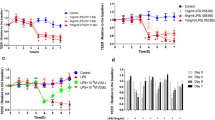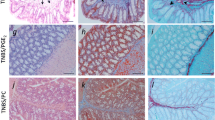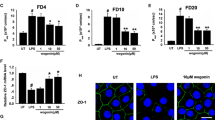Abstract.
Proinflammatory cytokines and secretory phospholipase A2 (sPLA2) are elevated in patients with inflammatory bowel disease (IBD). We previously reported that the proinflammatory cytokine IL-6 increased the expression of sPLA2 (a hydrolyzer of phosphatidylcholine) and decreased membrane integrity in an intestinal epithelial cell culture model. To determine the physiological effects of the IL-6 mediated increase in sPLA2 on decreased epithelial layer integrity, we investigated alterations of intracellular/secretory phospholipid (PL) composition in a cell culture model. In addition, since other PLs may also mediate epithelial membrane activity, we investigated the effect of IL-6 on PL activity in a Caco-2 enterocyte culture model. Caco-2 cells were incubated for 72 h with IL-6 or media alone (control). Both media and cell lysate were analyzed for PL composition using thin-layer chromatography. The PL composition in the media did not show any differences between the two groups (p>0.1). Total intracellular PL contents were also unchanged; however, IL-6 led to significant changes in PL composition including an increase in phosphatidylethanolamine (PE) and sphingomyelin (SM) and a decrease in phosphatidylcholine (PC) and lysophosphatidylcholine (LPC) (p<0.05). Both PE and SM are known as inflammatory signaling factors involved in human IBD. Our study suggests that the decreased membrane integrity seen with IL-6 application may occur via intracellular PL alterations, rather than through the direct effects of sPLA2.




Similar content being viewed by others
References
Sartor RB (1994) Cytokines in intestinal inflammation: pathophysiological and clinical considerations. Gastroenterology 106:533–539
Sartor RB (1994) Cyclosporine therapy for inflammatory bowel disease. N Engl J Med 330:1897–1898
Reinecker HC, Steffen M, Witthoeft T, Pflueger I, Schreiber S, MacDermott RP, Raedler A (1993) Enhanced secretion of tumour necrosis factor-alpha, IL-6, and IL-1 beta by isolated lamina propria mononuclear cells from patients with ulcerative colitis and Crohn's disease. Clin Exp Immunol 94:174–181
Gennari R, Alexander JW, Pyles T, Hartmann S, Ogle CK (1994) Effects of antimurine interleukin-6 on bacterial translocation during gut-derived sepsis. Arch Surg 129:1191–1197
Kishikawa H, Miura S, Yoshida H, Hirokawa M, Nakamizo H, Higuchi H, Adachi M, Nakatsumi RC, Suzuki H, Saito H, Ishii H (2002) Transmural pressure induces IL-6 secretion by intestinal epithelial cells. Clin Exp Immunol 129:86–91
Molmenti EP, Ziambaras T, Perlmutter DH (1993) Evidence for an acute phase response in human intestinal epithelial cells. J Biol Chem 268:14116–14124
Ziambaras T, Rubin DC, Perlmutter DH (1996) Regulation of sucrase-isomaltase gene expression in human intestinal epithelial cells by inflammatory cytokines. J Biol Chem 271:1237–1242
Vadas P, Scott K, Smith G, Rajkovic I, Stefanski E, Schouten BD, Singh R, Pruzanski W (1992) Serum phospholipase A2 enzyme activity and immunoreactivity in a prospective analysis of patients with septic shock. Life Sci 50:807–811
Vadas P (1984) Elevated plasma phospholipase A2 levels: correlation with the hemodynamic and pulmonary changes in gram-negative septic shock. J Lab Clin Med 104:873–881
Otamiri T, Franzen L, Lindmark D, Tagesson C (1987) Increased phospholipase A2 and decreased lysophospholipase activity in the small intestinal mucosa after ischaemia and revascularisation. Gut 28:1445–1453
Tagesson C, Telemo E, Ekstrom G, Westrom B (1987) Development of phospholipase A2 and lysophosphatidylcholine metabolising enzyme activities in the neonatal rat intestine. Gut 28:822–828
Sawai T, Drongowski RA, Lampman RW, Coran AG, Harmon CM (2001) The effect of phospholipids and fatty acids on tight-junction permeability and bacterial translocation. Pediatr Surg Int 17:269–274
Holch JLM, Sloane Stanley GH (1959) A simple method for the isolation and purification of total lipids from animal tissues. J Biochem 226:497–509
Weinhold PAVC (1965) Phospholipid metabolism in the liver and lung of rats during development. Biochim Biophys Acta 106:540–550
Abe A, Gregory S, Lee L, Killen PD, Brady RO, Kulkarni A, Shayman JA (2000) Reduction of globotriaosylceramide in Fabry disease mice by substrate deprivation. J Clin Invest 105:1563–1571
Brown KA, Back SJ, Ruchelli ED, Markowitz J, Mascarenhas M, Verma R, Piccoli DA, Baldassano RN (2002) Lamina propria and circulating interleukin-6 in newly diagnosed pediatric inflammatory bowel disease patients. Am J Gastroenterol 97:2603–2608
Murakami M, Kuwata H, Amakasu Y, Shimbara S, Nakatani Y, Atsumi G, Kudo I (1997) Prostaglandin E2 amplifies cytosolic phospholipase A2- and cyclooxygenase-2-dependent delayed prostaglandin E2 generation in mouse osteoblastic cells. Enhancement by secretory phospholipase A2. J Biol Chem 272:19891–19897
Balsinde J, Balboa MA, Li WH, Llopis J, Dennis EA (2000) Cellular regulation of cytosolic group IV phospholipase A2 by phosphatidylinositol bisphosphate levels. J Immunol 164:5398–5402
Pruzanski W, Keystone EC, Sternby B, Bombardier C, Snow KM, Vadas P (1988) Serum phospholipase A2 correlates with disease activity in rheumatoid arthritis. J Rheumatol 15:1351–1355
Minami T, Tojo H, Shinomura Y, Komatsubara T, Matsuzawa Y, Okamoto M (1993) Elevation of phospholipase A2 protein in sera of patients with Crohn's disease and ulcerative colitis. Am J Gastroenterol 88:1076–1080
Minami T, Tojo H, Shinomura Y, Matsuzawa Y, Okamoto M (1994) Increased group II phospholipase A2 in colonic mucosa of patients with Crohn's disease and ulcerative colitis. Gut 35:1593–1598
Minami T, Tojo H, Shinomura Y, Tarui S, Okamoto M (1992) Raised serum activity of phospholipase A2 immunochemically related to group II enzyme in inflammatory bowel disease: its correlation with disease activity of Crohn's disease and ulcerative colitis. Gut 33:914–921
Yamashita S, Yamashita J, Ogawa M (1994) Overexpression of group II phospholipase A2 in human breast cancer tissues is closely associated with their malignant potency. Br J Cancer 69:1166–1170
Minami T, Zushi S, Shinomura Y, Matsuzawa Y (1996) Phospholipase A2 stimulation of rat intestinal epithelial cell (IEC-6) migration. Am J Physiol 271:G664–G668
Longo WE, Grossmann EM, Erickson B, Panesar N, Mazuski JE, Kaminski DL (1999) The effect of phospholipase A2 inhibitors on proliferation and apoptosis of murine intestinal cells. J Surg Res 84:51–56
Bertsch T, Banks RE, Forbes MA, Aufenanger J, Storr M, Illingworth JM, Perren TJ, Selby PJ, Kattermann R (1996) Phospholipase A2 activity in serum is induced during treatment with recombinant human interleukin-6 in patients with cancer. Ann Clin Biochem 33:565–567
Crowl RM, Stoller TJ, Conroy RR, Stoner CR (1991) Induction of phospholipase A2 gene expression in human hepatoma cells by mediators of the acute phase response. J Biol Chem 266:2647–2651
Homan R, Hamelehle KL (1998) Phospholipase A2 relieves phosphatidylcholine inhibition of micellar cholesterol absorption and transport by human intestinal cell line Caco-2. J Lipid Res 39:1197–1209
Hannun YA (1994) The sphingomyelin cycle and the second messenger function of ceramide. J Biol Chem 269:3125–3128
Kolesnick R (2002) The therapeutic potential of modulating the ceramide/sphingomyelin pathway. J Clin Invest 110:3–8
Dobrowsky RT, Kolesnick RN (2001) Analysis of sphingomyelin and ceramide levels and the enzymes regulating their metabolism in response to cell stress. Methods Cell Biol 66:135–165
Author information
Authors and Affiliations
Corresponding author
Rights and permissions
About this article
Cite this article
Tazuke, Y., Drongowski, R.A., Teitelbaum, D.H. et al. Interleukin-6 changes tight junction permeability and intracellular phospholipid content in a human enterocyte cell culture model. Ped Surgery Int 19, 321–325 (2003). https://doi.org/10.1007/s00383-003-1003-8
Accepted:
Published:
Issue Date:
DOI: https://doi.org/10.1007/s00383-003-1003-8




